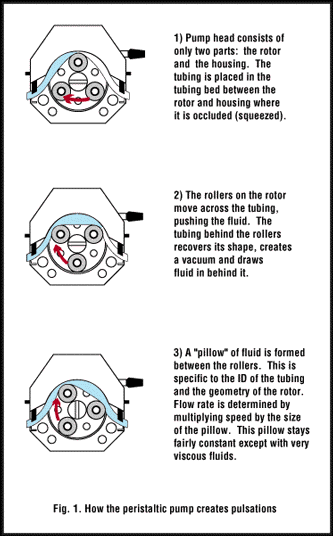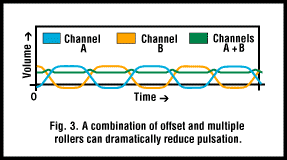Reduzierung der Pulsation in Perstaltikpumpensystemen
Some applications for persistaltic pumps. especially in the laboratory, are sensitive to pulsating fluid flow. A number of steps can be taken to reduce the pulsating effect.
Introduction to Pump Pulsation

As fluid enters the head of a peristaltic pump, it becomes trapped between two rollers. This "pillow" of fluid is followed by a void, where the tubing is occluded by the rollers. Alternating pillows and voids cause fluid flow to be pulsated, rather than smooth and continuous (Figure 1).
If pulsation is undesirable, using a pump head with adjustable occlusion can lessen the pulsation by a quarter. Reducing occlusion decreases the degree of pulsation because there is less distinction between fluid pillows. Some applications, however, are more sensitive to the pulsating flow produced by a peristaltic pump. These applications may require smoothing the flow by more than 25%. In these cases, four other methods may be considered for reducing pulsation further: using pump heads with offset occlusion and multiple-roller design; mounting multiple pump heads at an offset; using a pulse dampener; and changing the configuration of the discharge tubing.
Multiple Pump Rollers

Many peristaltic pump heads include two or three rollers, and are designed with the point of maximum occlusion at top dead centre (TDC) of the pump head (Figure 1). However, certain pump heads incorporate six or eight rollers, and are designed with offset occlusionthat is, with the point of maximum occlusion rotated away from TDC (Figure 2). The combination of these two design features can be exploited to practically eliminate pulsation.
Two cartridges (or tubing beds) with offset occlusion can be mounted in opposite directions of the pump head, so that their respective points of maximum occlusion are on opposite sides of TDC. The inlets and outlets of each channel can be joined with Y-connectors, so that fluid pulses arrive alternately at the Y-connector on the outlet side. Because pillow and void volumes are nearly identical with a six- or eight-roller pump head, each pillow almost evenly fills the void between pillows in the opposite channel. Fluid pulsation with the additional rollers, while higher in frequency, is also lower in amplitude. The result is nearly pulseless flow (Figure 3). This solution is ideal for lower flow rates of 460 ml/min or less.

For flow rates above 460 ml/min, the same principle of offset occlusion can be applied, although with slightly less favourable results. Pump heads with maximum occlusion at TDC can be coupled together, provided that coupling permits the rotors to be offset from each other. Optimum conditions apply when pump heads are offset 50% of the distance between rollers. In this configuration, the rollers do not reach TDC at the same time, so pillows and voids alternate between adjacent pumping channels. If the inlets and outlets of each channel are joined with Y-connectors, the pillow from one channel fills the void from the other on the outlet side. These pump heads, however, produce a larger pillow-to-void ratio than do pump heads with six or eight rollers. As a result, pillows from adjacent channels overlap one another to some extent, and pulsation is reduced only by 80-95%.
Pulse Dampeners
A pulse dampener can be inserted into the discharge line to reduce pulsation. As the pulsating flow enters the dampener vessel, the air pocket trapped above the fluid absorbs up to 90% of the pulsation. A smoother flow leaves the vessel.
For all tubing sizes, a pulse dampener can easily be fabricated using a retaining vessel and appropriately sized fittings, The outlet of the dampener should be at the same height as, or lower than, the inlet in order to reduce dead volume. Both inlet and outlet should be located near the bottom of the vessel to trap air in the top of the vessel.
Changing the configuration of the channel through which the tubing flows can also reduce pulsation. Extending the length of the discharge tubing several times and selecting a softer tubing material, such as silicone, can reduce pulsation by as much as 60%. Softer tubing helps absorb fluid pulsation, and a longer discharge line increases friction. The increase in friction raises back pressure, which compresses the pulses together, thereby reducing pulsation.